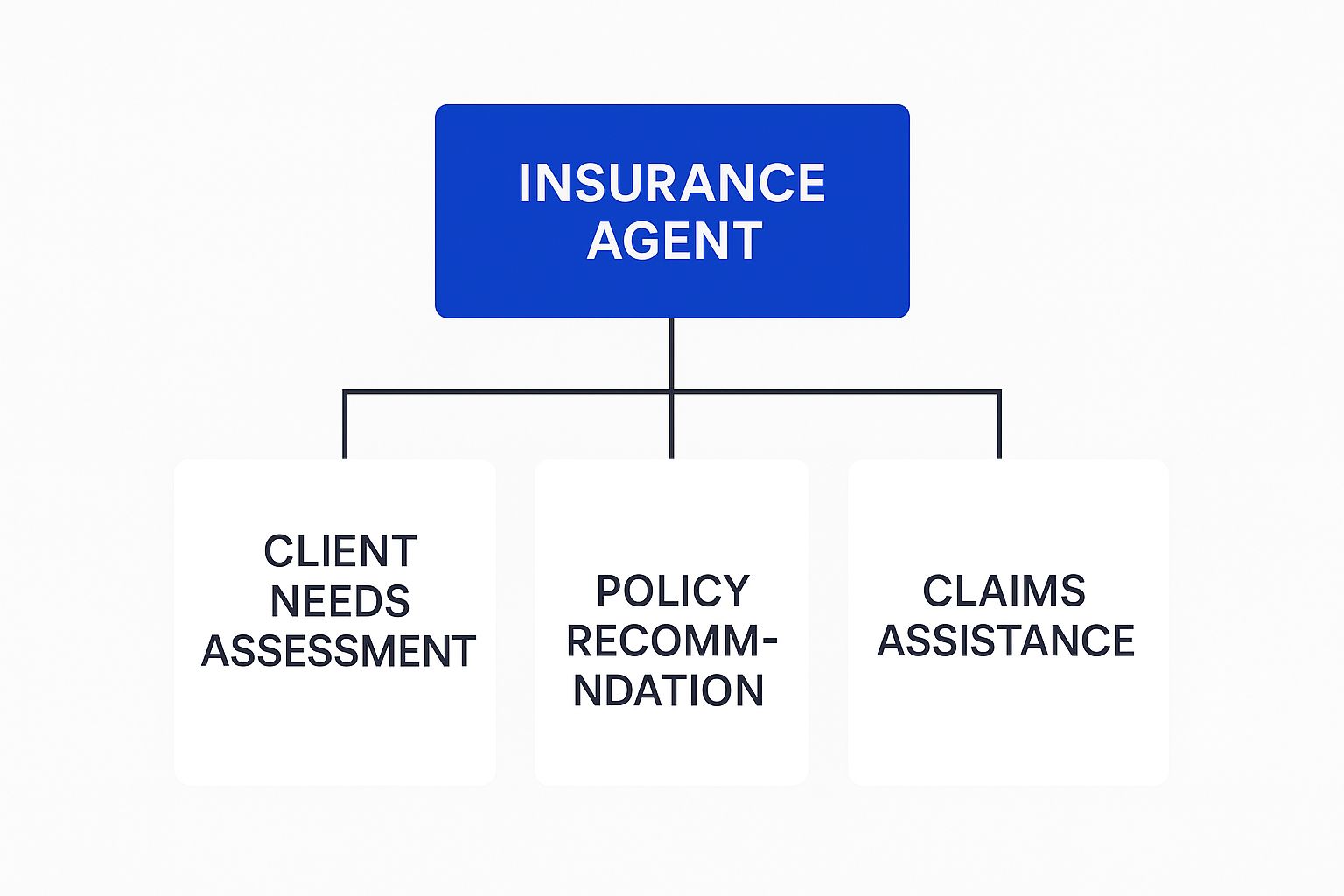An insurance agent is the critical link between an organization requiring risk transfer and the carriers that provide it. This role is not one of a simple salesperson; a strategic agent functions as a risk management consultant. Their primary responsibility is to analyze a client's commercial operations, identify material financial exposures, and engineer a robust insurance program to mitigate the impact of unforeseen events.
The agent's function is to safeguard a client's financial continuity and balance sheet against catastrophic loss.
The Core Mandate of an Insurance Agent
The primary role of an insurance agent extends far beyond transacting a policy. They are, fundamentally, a dedicated risk advisor. This position requires balancing a fiduciary-like duty to the client's best interests with the underwriting guidelines and business objectives of the insurance carriers they represent.
The process begins with a deep-dive analysis of a client's risk profile, whether for a small enterprise or a large, complex corporation. The agent must understand every potential vector of exposure. This involves asking targeted questions, performing a forensic review of existing coverages for critical gaps, and identifying vulnerabilities the client may not have recognized.
This diagnostic work is essential for preventing financial impairment. The agent’s analysis transforms a generic insurance product into a tailored risk transfer solution that performs as intended during a loss event.
A Duty of Diligence and Care
The agent-client relationship is governed by a professional duty of care. This is a significant legal and ethical responsibility, obligating the agent to act in good faith and with diligence. The focus must be on securing the *right* protection, not merely the lowest-priced option.
In practice, insurance agents serve as technical translators. They decipher complex, jargon-laden insurance contracts into clear business terms for the policyholders who depend on them. Regulatory bodies like the **National Association of Insurance Commissioners (NAIC)** establish standards, requiring agents to adhere to fair practice codes. This includes full transparency on policy costs, limitations, and, most critically, exclusions. Further detail on these professional standards can be found in industry analyses on platforms like **IRMI.com**.
This chart breaks down how an agent's responsibilities flow, from initial risk analysis to ongoing client and portfolio management.

Image
As illustrated, this is a continuous cycle. The agent's function does not conclude upon policy binding; it extends into claims advocacy and strategic reviews, proving the agent's long-term value as a risk partner.
To provide a clear overview, we've summarized the fundamental responsibilities that form the bedrock of the insurance agent's profession. This table offers an at-a-glance reference to the key pillars of their role.
Key Pillars of an Insurance Agent's Role
| Pillar of Responsibility | Core Function | Business Impact |
|---|---|---|
| Risk Analysis & Consultation | Identifying, assessing, and explaining a client's unique risk exposures. | Builds trust and ensures recommended coverage is relevant and necessary, reducing client vulnerability. |
| Policy Recommendation & Sales | Matching client needs with appropriate insurance products from carriers. | Drives revenue for the agency and carrier while providing clients with a tangible financial safety net. |
| Client Service & Advocacy | Assisting with policy changes, answering questions, and guiding clients through the claims process. | Increases client retention, generates referrals, and reinforces the agent's value beyond the initial sale. |
| Regulatory & Ethical Compliance | Adhering to all state and federal laws, industry regulations, and ethical standards. | Protects the agency from legal and financial penalties and maintains the trust of both clients and carriers. |
These pillars are interdependent, forming the foundation of a successful and ethical insurance practice.
An agent's true value isn't measured by the policies they sell, but by the financial disasters they help their clients avoid. Their expertise transforms a simple insurance policy into a robust financial safety net.
Ultimately, an agent's core mission is to deliver certainty. They achieve this through professional guidance and contractually sound protection, ensuring their clients can maintain operational resilience in the face of volatility.
Translating Client Needs into Protective Coverage

Image
This is where an expert insurance agent demonstrates their value. One of the most critical insurance agents responsibilities is the ability to translate a client's operational narrative—their processes, exposures, and strategic goals—into a structured program of insurance coverage.
This process transcends ticking boxes on a generic application. It requires a forensic approach to uncover the unique risks and latent exposures that could trigger significant financial or operational disruption for a business.
The process is initiated with a thorough needs analysis. A seasoned agent asks probing, intelligent questions, scrutinizes existing policies for dangerous gaps, and highlights exposures the client may not have considered. This duty of care is a professional imperative. While some state laws may not formally require an agent to advise on coverage adequacy unless a “special relationship” exists, a true professional operates proactively and meticulously from the outset.
A key component is demystifying policy language. The agent must be able to explain the practical, real-world implications of contract terms, not just their legal definitions. For example, making sure a client understands the operational impact of their policy is fundamental, and a key part of understanding an indemnity clause is communicating its business impact clearly.
From Risk Assessment to Policy Recommendation
Once the risk landscape is mapped, the next step is to structure the coverage. This involves selecting and tailoring insurance products that align precisely with the client’s operational realities and risk appetite. The objective is to achieve an optimal balance: coverage robust enough to respond to a catastrophic event without burdening the client with excessive premium for unneeded protection.
Consider a growing restaurant as a practical example. A sharp agent looks beyond the obvious.
- Property & Liability: They will assess the building for fire risks and the kitchen for equipment breakdown. They will also analyze general liability for patron injury, such as a slip-and-fall.
- Business Interruption: This is a critical and often misunderstood coverage. The agent will calculate the potential income loss if a fire forced a multi-month closure, ensuring business continuity.
- Specialized Risks: The analysis extends to spoilage coverage for perishable inventory and liquor liability if alcohol is served.
Following this 360-degree review, the agent can recommend a tailored commercial package policy. This strategy often bundles necessary coverages, proving more cost-effective and providing more seamless protection than a patchwork of standalone policies. You can see how these packages are constructed in our detailed guide to [commercial insurance coverage](https://insurtech.bpcorp.eu/pages/coverage).
An agent's core skill is connecting a client’s day-to-day operations to potential financial catastrophe. They translate abstract risks into a concrete, contractual promise of support from an insurance carrier.
This work is dynamic. As a client’s business evolves—through hiring, acquisitions, or expansion—the agent must reassess and adjust the coverage. This ongoing stewardship ensures the client’s financial shield remains properly calibrated to new risks, cementing the agent's role as a vital, long-term partner in risk management.
Guiding Clients Through Market and Pricing Shifts

Image
The commercial insurance market is never static. It is a dynamic environment subject to cyclical pressures and unforeseen volatility. An effective agent does not merely place policies; they serve as a market navigator, guiding clients through the often-turbulent conditions of market cycles.
One of an agent's most critical responsibilities is to translate complex market dynamics—from sudden premium increases to tightening terms and reduced capacity—into clear, actionable business intelligence. This is not a courtesy; it is a core function that elevates the agent from a vendor to an indispensable advisor. Empowering clients to make informed decisions about their risk programs builds long-term trust that transcends any single policy term.
Interpreting Hard and Soft Market Cycles
The insurance market oscillates between "soft" and "hard" conditions. Each phase presents distinct challenges and opportunities, and an experienced agent understands how to execute a strategy appropriate for the prevailing environment.
- Soft Market Advocacy: During a soft market, carriers compete aggressively for market share. This competition drives down premiums, broadens coverage terms, and increases capacity. Here, the agent’s primary role is to be an aggressive advocate, leveraging market conditions to secure the most favorable rates and terms for their clients.
- Hard Market Counsel: A hard market is the inverse. Premiums escalate, underwriting becomes more restrictive, and certain coverages may become difficult to place at any price. In this environment, an agent’s duty shifts to providing transparent, realistic counsel. They must clearly articulate the market drivers behind rate increases—such as major catastrophe losses or poor industry-wide results—and then work strategically to engineer viable coverage solutions.
Without this expert guidance, clients are left feeling blindsided and unsupported during difficult renewals, unaware of the powerful market forces at play.
The Agent's Role as a Market Analyst
Beyond explaining market cycles, a modern agent must function as a frontline market analyst. They possess direct insight into how macroeconomic trends, carrier profitability, and catastrophic events impact policy availability and pricing for their clients.
For example, a resource like the Global Insurance Market Index from Marsh.com provides a high-level view of pricing trends. However, it is the agent on the ground who must translate that macro data into practical, actionable advice for a specific business.
This role is especially vital for small to mid-sized businesses, which are often most vulnerable to pricing shocks. An agent specializing in this sector must be adept at finding solutions that provide robust protection without jeopardizing a client's financial stability. This dynamic is explored in our guide on insurance for small landscaping businesses.
The agent's role is not just to find a policy but to provide market intelligence. By clarifying *why* prices are changing, they transform a frustrating experience into an informed business decision, solidifying their position as a trusted advisor.
Ultimately, by managing expectations and delivering clear, data-backed communication about market conditions, an agent demonstrates their true value. They transform market volatility from an unmanageable threat into a known variable within a client’s long-term risk management strategy.
Ensuring Accuracy in Policy Administration
<iframe width="100%" style="aspect-ratio: 16 / 9;" src="https://www.youtube.com/embed/M_hLYKYFS5w" frameborder="0" allow="autoplay; encrypted-media" allowfullscreen></iframe>
While strategic advice is the most visible aspect of an agent’s role, meticulous policy administration is the behind-the-scenes work that protects the integrity of the insurance contract. This is not simply about paperwork; it is about ensuring the agreement between the insurance carrier and the insured is accurate and binding from inception through renewal.
The agent functions as the steward of the client's policy data. Every detail, from the initial application to a mid-term endorsement, must be handled with precision. This critical function ensures that a policy will perform as expected when a claim is filed.
Seemingly minor administrative errors—a mistyped vehicle identification number, a misclassified employee, or a mishandled payment—can have significant consequences. A data entry error can create a coverage gap or, in a worst-case scenario, lead to a claim denial, undermining the very protection the client has purchased.
The Lifecycle of Policy Management
Effective policy administration is not a one-time task; it is a continuous cycle. An agent’s duties span the entire policy lifecycle, demanding proactive management and clear communication to keep coverage perfectly aligned with a client’s evolving operations.
Key administrative responsibilities include:
- Application and Issuance: Verifying the accuracy of all information on an application before submission to an underwriter. This foundational step is critical to contract validity.
- Endorsements and Changes: Accurately processing client requests, such as adding a new vehicle, increasing property limits, or updating the named insureds on a complex liability form.
- Payment and Billing: Ensuring premium payments are posted correctly and clarifying billing inquiries to prevent an inadvertent lapse in coverage.
- Renewal Management: Proactively managing the renewal process by communicating any changes in premium or terms and confirming the client’s instructions to bind coverage for the next term.
These responsibilities demand a high degree of organization and diligence. Any failure not only exposes the client to uninsured loss but also exposes the agent to significant professional liability. For a deeper understanding of this exposure, review our detailed overview of [E&O insurance for insurance agents](https://insurtech.bpcorp.eu/blog/e-and-o-insurance-for-insurance-agents-1754293360904).
An insurance policy is not a static document. It is a living contract that must accurately reflect the client’s real-world exposures. The agent's administrative function ensures this alignment, which is the only way for the policy to perform correctly at the time of a claim.
Ultimately, executing the administrative function flawlessly reinforces an agent’s value as a dependable partner. It demonstrates a commitment to the client's financial well-being that extends far beyond the initial transaction, building the long-term trust essential to any professional advisory relationship.
Adapting to Emerging Risks and New Technology

Image
The risk landscape for commercial entities is undergoing a fundamental transformation. The agent's historical focus on traditional perils like fire and theft is now merely the baseline. The modern agent must be a forward-looking risk advisor, responsible for guiding clients through an expanding matrix of new and complex threats.
An agent's role has evolved beyond known perils to demand proactive identification of emerging exposures. This includes sophisticated cyber attacks, the increasing frequency and severity of climate-related disasters, and the operational impacts of artificial intelligence. This shift requires agents to be continuous students of risk, educating themselves on new vulnerabilities and the specialized insurance products designed to address them.
Educating Clients on New Exposures
A significant component of these expanded insurance agents responsibilities is translating complex new risks into material business terms for clients. It is one thing for an agent to know a cyber attack is a threat; it is another to clearly articulate how it could trigger a contingent business interruption loss in a client's supply chain, or how a single flood event could impair operations.
This advisory role is becoming essential as global risk factors intensify. For instance, the International Association of Insurance Supervisors (IAIS) recently identified climate and cyber risks as top concerns in a Global Monitoring Exercise. Their report underscores the market expectation that agents be fluent in the specialized policies these threats necessitate. The market has shifted from generalist coverage to highly specific risk transfer solutions, and agents must lead this strategic conversation.
Climate change, in particular, has become a primary focus. Agents are now tasked with translating abstract climate science into tangible business risks. To learn more about this critical area, review our guide on [how climate change impacts business operations](https://insurtech.bpcorp.eu/blog/climate-change-business-impact-1753686460888) and the coverages required to build resilience.
An agent's responsibility is no longer just to sell a policy, but to provide foresight. They must help clients see around corners, anticipating risks that are not yet on their radar but pose a clear and present danger to their future.
The Influence of Technology on an Agent's Role
Technology, particularly artificial intelligence, is reshaping the insurance industry. AI-driven underwriting models can now analyze massive datasets to evaluate risk with unprecedented precision. This directly impacts everything from policy pricing and terms to a client's fundamental insurability.
An effective agent must understand how these tools operate to advocate successfully for their clients. As technology becomes more central to the industry, agents who embrace [data-driven decision making](https://vizule.io/data-driven-decision-making/) will hold a significant competitive advantage. It enables them to provide more accurate advice and better navigate the complexities of modern underwriting.
This is the new paradigm. The agent has transformed from a policy transactor into a tech-enabled risk advisor, equipped to address the complex challenges of the modern business environment.
Answering Your Top Questions About Agent Duties
When dealing with a function as critical as risk management and insurance, clarity is essential. Whether you are a business owner, a new broker, or a seasoned risk manager, the lines of responsibility can sometimes seem ambiguous. Here we address some of the most common questions regarding an insurance agent's duties.
Captive Versus Independent Agents
This is a fundamental distinction that directly impacts a client's options. Understanding an agent's market representation is key.
- A captive agent represents a single insurance company. They are specialists in that carrier's product suite and can only offer policies from that one insurer.
- An independent agent operates as a market intermediary. They hold appointments with multiple insurance companies, allowing them to compare policies, terms, and pricing from various carriers to find the optimal solution for a client's specific risk profile.
The Agent's Dual Responsibilities
To whom is an agent's primary duty owed—the client or the insurance company? A professional agent serves both, maintaining a delicate but critical balance.
First, agents have a fiduciary duty to their clients. This is a legal and ethical obligation to act in the client's best interests. This entails recommending appropriate coverage, providing full disclosure on policy limitations, and helping manage risk effectively.
Concurrently, the agent is bound by contract to the insurance carriers they represent. They must adhere to underwriting guidelines, present risks accurately, and operate in good faith with their carrier partners.
An agent's responsibility is a two-way street. They must be a trusted advocate for the client while also being a reliable partner to the insurer, ensuring the integrity of the insurance contract is upheld on all sides.
An Agent's Ongoing Service Commitment
Does the agent's role conclude after policy placement and commission payment? For a true professional, the transaction is merely the beginning of a long-term strategic partnership.
A significant part of an agent's role involves providing continuous service and support throughout the policy term and beyond. This ongoing commitment is what differentiates a simple salesperson from a risk advisor. It includes:
- Policy Service: Executing mid-term changes, such as adding a new vehicle to a commercial auto policy or updating property values.
- Renewal Management: Proactively reviewing coverage ahead of renewal, communicating market changes, and ensuring the policy remains aligned with the client’s current operations.
- Claims Advocacy: In the event of a loss, the agent serves as the client's first point of contact and advocate, guiding them through the process and interfacing with the carrier's claims adjuster.
This continuous relationship is vital, particularly for businesses facing dynamic risks. For instance, our guide on [disaster preparedness for businesses](https://insurtech.bpcorp.eu/blog/disaster-preparedness-for-businesses-1753512966451) highlights how critical an agent's ongoing counsel is for building resilience against modern threats.
How Agents Get Paid
Transparency in compensation is fundamental to trust. Agents are typically compensated via commissions paid by the insurance carriers whose policies they place.
This commission is a percentage of the policy premium and is already built into the final price. The client does not pay a separate, additional fee for the agent's advice, expertise, and ongoing service. This model is designed to incentivize the agent to secure the right coverage and provide excellent service to retain the client's business over the long term.
---
At Sentinel Shield by BPC GROUP, we empower brokers and agents to connect with high-intent commercial clients precisely when they need help the most. Our platform delivers real-time, geo-targeted leads of businesses impacted by climate events, turning crises into opportunities for you to provide critical support and build lasting relationships. Stop chasing cold leads and start engaging prospects at their moment of need. Learn more about our performance-based lead generation at https://insurtech.bpcorp.eu.